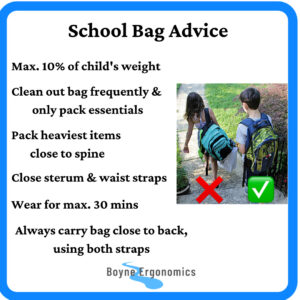It is that time of year again, when shopping for school supplies has begun. The schoolbag, or backpack, is a vital piece of equipment. It will be used to transport supplies at least twice a day, placing loads on the developing spine. Correct schoolbag selection for the user and correct schoolbag use will ensure that you are protecting the musculoskeletal development of the young user and instilling good habits for the future.
In this blog post, I will describe what you should consider when buying a schoolbag, or back pack, for a child, or yourself, to reduce the risk of musculoskeletal strain or injury.
Appropriate School Bag Selection
Firstly, make sure that the size of the schoolbag is appropriate for the user. All too often, I see small school-goers around schools with bag so big you cannot see the child from behind!
It is recommended that the bag should be no wider than the chest, and sit no lower than the hollow of the back once straps are adjusted. If the bag is too big it will not sit correctly on their back.
If possible, try the schoolbag on the child to ensure it is the correct size for them. Alternatively, if like me, your small person is demanding a particular bag that can only be purchased online, measure the length from their shoulder to the hollow of the back and select the ideal bag size.
Structurally, ensure the back has a moulded frame. This will ensure the bag can sit comfortably against the back and help distribute the load on the hips and back instead of the shoulders.
Padded straps will ensure that the weight is distributed evenly and comfortably across the shoulders.
When selecting a school bag, adjustable waist and sternum straps allow the bag to remain close to the back, reducing the risk of forward leaning postures and reducing the load on the spine.
Separate compartments allow for even distribution of the contents.

Wheeled schoolbags can be a good alternative to the standard self-carry schoolbag, as long as the user is comfortable wheeling it and is able to safely bring it on and off transport if required.

Appropriate School Bag Use
Once you have the selected the ideal school bag, the next step is to encourage appropriate use to ensure minimal load, even weight distribution, reduce fatigue and discourage adverse postures.
The recommended maximum weight of the school bag, depending on the source, is 10-15% of the weight of the child / user.
To help keep the weight of the bag as low as possible, clean out the bag frequently and only pack essential items. This will help reduce strain on the upper back, neck and shoulders and help maintain balance, avoiding over-correcting and forward leaning.
When packing the bag, keep the heaviest items at the back of the bag, close to the spine.
The bag should be carried close to the back, using both shoulder straps, to ensure even distribution of the load.
If the bag has waist and sternum straps, close them to help keep the bag close to the back.
Finally, the school bag should be caried for a maximum of 30 minutes. The bag should be taken off if waiting for transport, like the bus stop, or when in transit. If walking to school, grownups feel free to take the bag for a while to lighten the load!

I know that it can be difficult to compromise between the bags the young wearer wants and the bag that suits their stature and even more difficult to encourage appropriate school bag use, but gentle encouragement and introducing the habit early can be hugely beneficial to their long-term musculoskeletal health.


